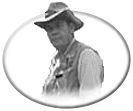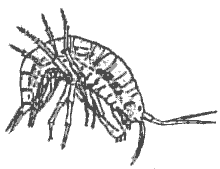 GAMMARUS
SHRIMP GAMMARUS
SHRIMP
article
by Ron Newman
Scientific
Name:
- Class
- Crustacea. Order - Amphipoda. Family - Gammaridae
Common
Names:
- Gammarus
Shrimp, Shrimp, Scuds, Side Swimmers
 General:
General:
- There
are two types of freshwater Shrimp in our interior lakes. These are
the Hyella shrimp and the Gammarus shrimp. At a casual glance, the only
visible difference is in their size. The Hyella never grow as large
as the Gammarus. Trout feed on both but a large Hyella imitation would
be tied on size 18 to 20 hooks. Except for this size difference, the
following discussion is applicable to both shrimp. Also note that these
are not Fairy Shrimp.
Life Cycle:
- The shrimp
will mate several times per year. During this process the male carries
the female on his back as they are swimming. The female carries about
50 fertilized eggs in her egg pouch and these are orange in color and
show through her semi-transparent body. The young shrimp hatch within
the egg pouch and emerge as fully developed young shrimp but microscopic
in size. The young develop an exo-skeleton but molt this a number of
times as they increase in size. Sometimes these discarded exo-skeletons
can be seen floating on the lake surface. Since the shrimp have no natural
defense mechanisms, except camouflage, they usually hide in the Chara
weeds and are more active during periods of low sunlight or after dark.
Apperance:
- The Gammarus
Shrimp are semi-transparent and are laterally compressed. That is to
say that they are thicker from top to bottom than they are from side
to side. They have two pair of grasping legs near the head, five pair
of legs for walking at mid-body, three pair of ciliated leg like appendages
for swimming on what would be the abdomen, and one pair of hind legs
to assist with eating in a curled position at the tail. They have eleven
body segments (one for each set of appendages). The head has two longish
antennas and the tail section has two short protrusions.
Size:
- Up to
20 mm (3/4 inch) in length but adults usually average about 15 mm (1/2
inch) in length.
Colour:
- What they
have been eating and their immediate surroundings usually determine
the coloration of shrimp. Being semi-transparent, the entire digestive
tract of the shrimp shows through their shell. Although they scavenge
on animal material, their primary food is often plant material and blue-green
algae. The plants and algae causes most shrimp to appear as various
shades of green, and sometimes into shades of bluish hues. However,
the immediate surroundings can sometimes offset that color. For example,
in lakes with reddish brown bottom mud, the mud is often ingested with
the algae and the shrimp tend to take on the coloration of the mud.
Whether plants or mud, the shrimp is usually well camouflaged with it's
surroundings. Worthy of note is the orange coloration of the eggs carried
within a pregnant female.
Movement:
- The shrimp
will swim for 5 to 10 inches and then stop to rest and breath. When
stopped, they sink toward the bottom, usually in a curled position.
After a few seconds they will uncurl and swim another short distance.
This swimming and sinking is very erratic and is a good way to retrieve
a fly representing the shrimp. The legs of the shrimp are constantly
in motion to circulate water over their gills. When mating, the shrimp
can be seen swimming in tandem, one on top of the other. Sometimes flies
are tied to imitate a mating pair of shrimp.
Habitat:
- Gammarus
Shrimp are generally scavengers and feed on plant and animal material
that have settled to the bottom. On occasion they are predacious and
attack other injured or stressed aquatics. They tend to hide among the
weeds and under rocks or debris when not traveling or mating. They can
be found at most depths of the lake but are most common in water less
than 35 feet deep. Shrimp need calcium to build their shells or exo-skeleton.
Our lower elevation lakes tend to be high in dissolved salts and calcium
and those lakes are generally very productive in shrimp. Lakes with
Lily Pads tend to be more acidic and usually have lower populations
of shrimp.
Importance
to Fly Fishing:
 Freshwater
shrimp are the most important food source for trout in our interior
lakes. Throughout the fly fishing season, feeding samples show that
35% of the trout's daytime feeding consists of shrimp. This increase
to 42% for those fish feeding in the evening or at night. Whether in
the day or evening, no other aquatic food source matches the shrimp
in the trout's total diet. Freshwater
shrimp are the most important food source for trout in our interior
lakes. Throughout the fly fishing season, feeding samples show that
35% of the trout's daytime feeding consists of shrimp. This increase
to 42% for those fish feeding in the evening or at night. Whether in
the day or evening, no other aquatic food source matches the shrimp
in the trout's total diet.- The shrimp
are Crustaceans and unlike the insects, they do not go through the visual
transformations of larvae, pupa, and adult. They do not 'hatch' into
something else and never have a terrestrial form. The newly hatched
shrimp is just a smaller version of the adult. So, flies tied to imitate
the shrimp should come in a variety of sizes for the same pattern and
color combination.
- Although
they don't 'hatch', the shrimp do have 'peaks' as a food source for
the trout. They are most abundantly fed upon in the fall. Beginning
the first week of September, shrimp are eaten in large numbers and are,
by far, the main component of the feeding samples. Quantities 'peak'
about the second week of October and then steadily decline while still
remaining the primary food component. Although I don't fish or have
any records into the late fall (when ice is forming on the fly line
in late November), I presume this trend continues until ice-on.
- In terms
of total numbers of shrimp consumed, there are three other 'peaks' that
are about equal in importance. These are immediately after ice-off,
the last week in May, and the third week of July. The fly fisher often
ignores these three periods. Each period seems to have reasons why that
particular period is ignored. Right after ice-off the Waterboatmen are
steadily increasing in numbers. During the last week of May till the
first week in June the Chironomid are reaching their peak hatches. During
the third week of July, the Caddis hatches are sufficient in number
to draw attention to them, and away from the shrimp. If, during these
periods, what appears to be the main food source isn't working, then
try a shrimp pattern.
- The fourth
most important 'peak' is when the numbers of shrimp are down but the
percentage of shrimp consumed is fairly high. This occurs in mid-August,
during the summer downers. The water is warmer, the fish are deeper,
and the total numbers of aquatic 'bugs' are down. However, as a percent
of feed consumed, the shrimp are at a peak with the exception of the
late fall fishing.
Flies:
- Tying
a good shrimp pattern is a challenge for all fly fishers. I have only
seen about two, maybe three, patterns that come close to a 'good' imitation
of a shrimp. Try to imitate a laterally compressed body with lots of
legs or at least the impression of legs. Believe me, it isn't easy to
get the right look. Colors should usually be the greens or reddish browns
and I often tie a 'back' over the top of the fly that is darker than
the bottom of the body.
Fishing:
- If you
manage to come up with a good imitation of the shrimp, there are quite
a number of ways to fish the pattern. The fly can be tied weighted or
non-weighted. With a weighted fly, the imitation can be fished with
a floating, or a sinking line. Retrieve the fly about 5 to 10 inches
to bring it 'up' in the water column, then let sink for a second or
two and then repeat. Try variations on this to see what is working.
With a non-weighted fly, you will usually be fishing on a sinking line.
My favorite is a slow sink (Type 1) which allows the slowest retrieve
while still staying out of the sunken vegetation.
Hint:
- Try tying
your fly out of a buoyant material such as deer hair. Let your sinking
line go right to the bottom while your buoyant fly rides slightly above
the weed cover during the retrieve. With this approach your fly will
even occasionally dip into the weeds. The combination gives an erratic
movement and is a very effective way to fish shrimp patterns.
Last Notes:
- Try fishing
the shrimp patterns 'on' or near the bottom. This will normally produce
success. Larger fish have been known to swim along the bottom, sweeping
their tails to stir up the bottom materials, and then returning to see
if there are delicacies (such as shrimp) that suit their fancy. More
than once I have been broken-off with this 'on-bottom' retrieve. Freshwater
shrimp are perhaps the least understood of the aquatics, while being
the most important food source of the Kamloops Trout.
Recommended
Fly Patterns:
- Kevin's
Orange Shrimp
- Mylar
Shrimp
- Green
Baggie Shrimp
- Pregnant
Baggie Shrimp
- Crystal
Shrimp
- Orange
Crystal Shrimp
- Little
Guy
- Werner
Shrimp
Be
sure to read other articles by Ron Newman
Study
Other Insects
| Tip & Techniques
| Study Fly Patterns
|



 GAMMARUS
SHRIMP
GAMMARUS
SHRIMP General:
General:
 Freshwater
shrimp are the most important food source for trout in our interior
lakes. Throughout the fly fishing season, feeding samples show that
35% of the trout's daytime feeding consists of shrimp. This increase
to 42% for those fish feeding in the evening or at night. Whether in
the day or evening, no other aquatic food source matches the shrimp
in the trout's total diet.
Freshwater
shrimp are the most important food source for trout in our interior
lakes. Throughout the fly fishing season, feeding samples show that
35% of the trout's daytime feeding consists of shrimp. This increase
to 42% for those fish feeding in the evening or at night. Whether in
the day or evening, no other aquatic food source matches the shrimp
in the trout's total diet.